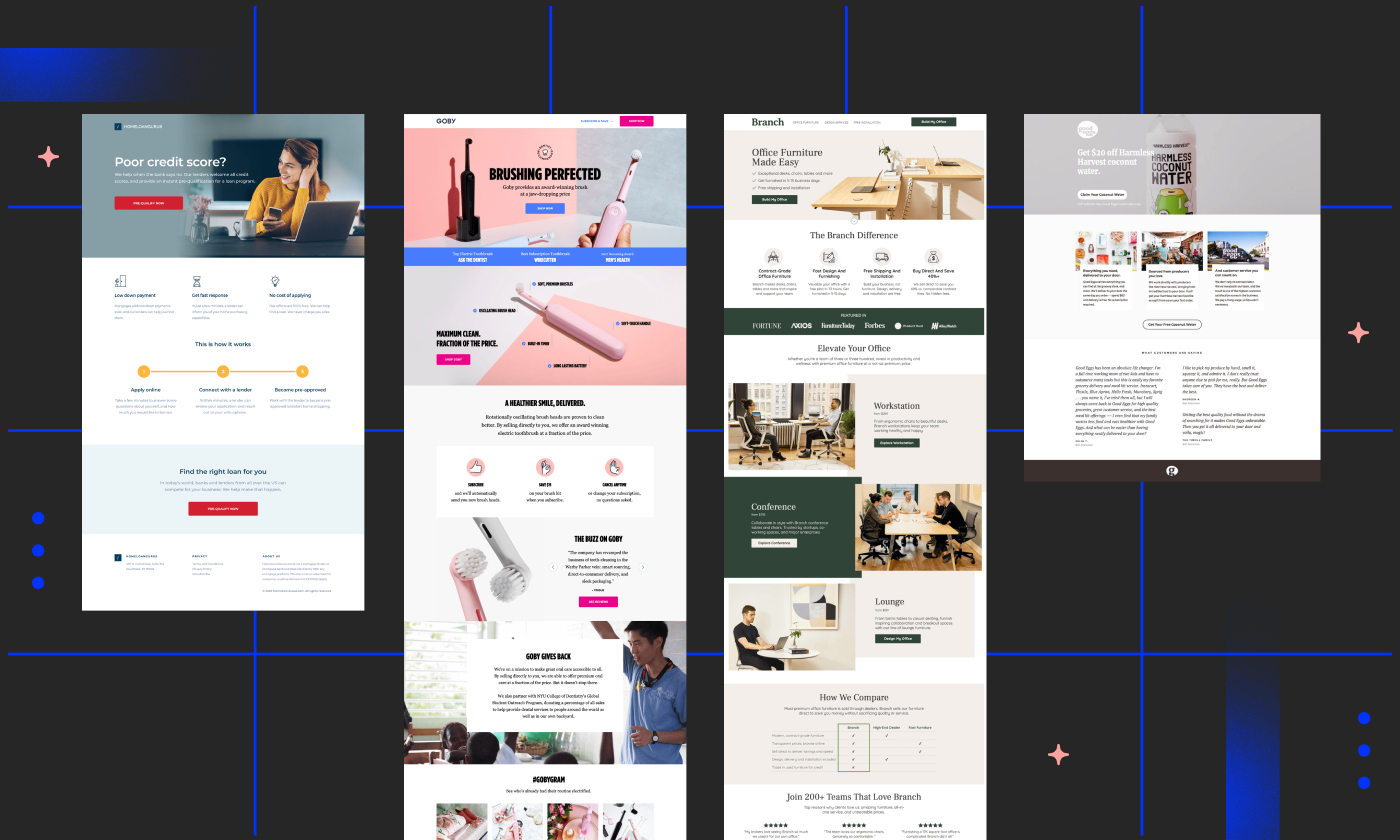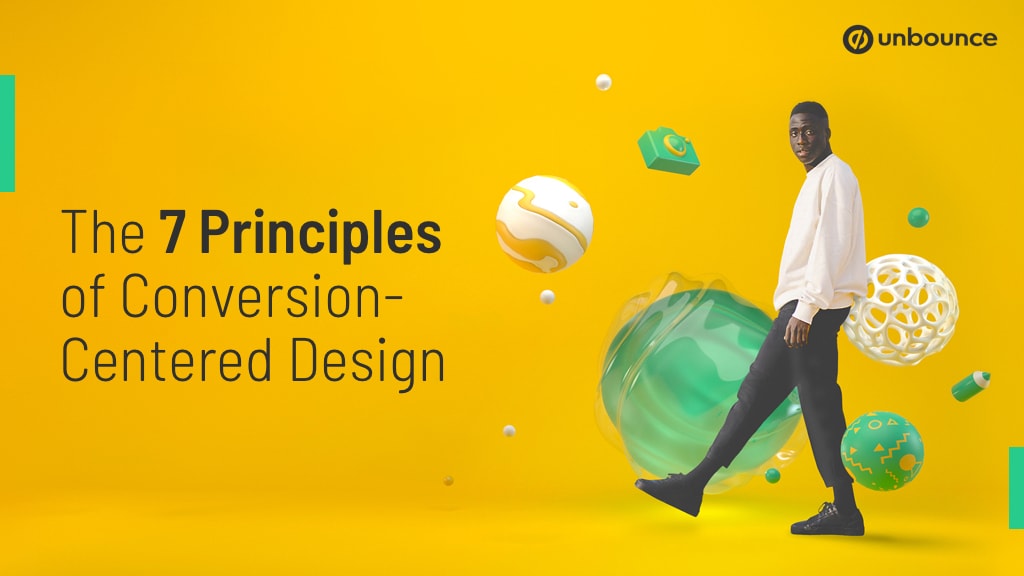
10 high-converting agency landing page examples (+ tips)
Ever feel like the successful agencies you see in the wild have superpowers?
It’s like they have x-ray vision for analytics and superhuman efficiency—not to mention super-speed with how fast they turn things around.
But here’s the thing:
The best agencies aren’t relying on superpowers—they’ve just got the right tools in their utility belt.
Chief among those tools?
TABLE OF CONTENTS
Landing pages are incredible tools for marketing agencies looking to make a splash. They’re infinitely customizable, easy to use, and deliver a wealth of data—more on that later.
We’ve collected 8 examples of how agencies are using high-converting landing pages that you can use to start your next super-powered campaign.
Why do successful agencies use landing pages?
If you’ve ever read virtually anything we’ve written here at Unbounce, then it shouldn’t be any big surprise that landing pages are among the best tools in a marketer’s tool belt—and the reasons why are pretty simple:
- They offer immediate, data-driven results: The convertible elements on a landing page give agencies the ability to scale, test and redesign instantaneously. As a result, you get immediate, data-driven findings.
- You can test creative ideas right away: Because a landing page can be spun up in minutes, you have the freedom and creativity to test your designs with minimal risk.
- Landing pages can save time: Bringing landing page strategy into your repertoire is accessible and intuitive. Agencies can empower current employees rather than hire expensive experts or additional team members.
- You can make your workflows more efficient: Because landing page stats are so easy to collect and analyze, agencies can drastically increase efficiency, no matter how small the team.
In other words, landing pages are incredibly useful marketing tools because they help you deploy and test ideas at a rapid pace, no matter your level of experience.
10 high-converting landing page examples to inspire your agency
So how exactly are marketing agencies using these awesome tools?
Let’s dig in.
1. UX Studio
UX Studio is a creative design agency with a focus on optimizing user experience (UX) on webpages and applications. This landing page is all about a special offer they have for three weeks of uplift to assess client pages, branding, and UX before building new assets.

Why it converts
The power of a simple but effective design obviously isn’t lost on UX Studio. Because it’s at the core of their agency, effective user experience is put to work here to guide visitors through key information quickly.
They’ve got a strong header image and a scrolling band of the clients they’ve worked with—a great way to display social proof and highlight past success quickly.
But one of the best features of this page is how quickly they call out pricing. In fact, pricing is their CTA, and they expand on their offer with additional content and copy to lay out exactly what prospects will get.
Tips for building your own
If you’re looking to build an effective landing page, remember: keep it simple.
The more you include on a landing page, the more room there is for a visitor to wander off and get distracted. UX Studio’s approach here already makes an assumption that, if you’re visiting, you know a thing or two about marketing, but need a helping hand when it comes to optimization.
As such, they don’t waste any time in getting to their offer. They put the pricing up front, and get out of the way to reduce friction and let the user take action.
2. SimpleTiger
SimpleTiger is a social media advertising agency with a focus on software-as-a-service (SaaS) businesses. Their landing page offer is centered around giving users a free demo of their solutions.

Why it converts
Strong, compelling headlines can make or break your landing page efforts. In the case of SimpleTiger, they’ve focused on a straightforward headline that focuses on the pain point many businesses face: SaaS companies need their marketing efforts to keep a steady flow of top-funnel leads coming in.
What’s more, this headline shows a respect for its target audience: Marketing to marketers can mean walking a tricky line between making things engaging enough to draw attention, but without losing focus on the specific challenges these visitors face.
Tips for building your own
Writing strong copy for a landing page headline (or any marketing materials, for that matter) is a real balancing act. Nailing it is key to your success—after all, this is where you’re making your pitch and backing it up with reasons to click.
When developing strong page copy, remember:
- It’s better to be clear than clever
- Make sure your headline message matches what’s in your ads
- Keep it simple: If it worked before, there’s no need to reinvent the wheel
All good headlines are trying to sell a benefit, solve a problem, and hook your readers. You don’t need to hit all these beats in one go, but keep them in mind whenever you get down to crafting and drafting your messages.
3. KlientBoost
KlientBoost is a performance marketing agency with a focus on boosting client ROI. Their landing page is a great example of how agencies can provide free assets and offers that add value.

Why it converts
This landing page takes a unique approach to the traditional form field. Instead of a long list of dropdown menu items, KlientBoost has simplified and streamlined things with a big emphasis on user experience.
To start with, there’s no up-front request for your information—instead, they’ve focused entirely on the challenges and problems you might be facing.
The first field is about channels and tactics. From there, you’re asked to identify your particular challenge (increasing ROI, boosting revenue, etc), and then you identify your company and provide details on who the marketing plan and other details should be sent to.
It’s a great approach to what can often be the biggest point of friction and contention in the landing page experience. The amount of actual information you’re providing is minimal, and there’s a big emphasis on helping you solve your problems.
Tips for building your own
Whenever you need to build a form of your own, remember:
The fewer fields your users have to fill out, the happier they’ll be.
Think of it this way: If you were having a conversation with a stranger, you wouldn’t want to ask all your questions at once, all in a row.
The best landing page forms use the breadcrumb technique to ask for a bit of information at a time. Do whatever you can to cut down on the number of fields a user has to fill out to avoid driving them away.
4. Landed
Landed is a hiring agency taking a different approach to helping businesses get the people they need for critical roles in their organizations.

Why it converts
If you’ve read through the other examples here, this page may not immediately jump out at you as a high-converting agency landing page.
But what stands out here is how Landed has prioritized directly speaking with their potential clients with the use of a chatbot.
Embedding a chatbot on a landing page is a great way to not only give visitors direct access to more information, but also to provide unique, targeted offers that are more likely to convert.
Landed have taken this to heart, giving visitors a way to skip the form process entirely and book a demo through chat. It reduces friction and doubles down on the offer without feeling pushy. The focus is on reducing touchpoints while providing value for the user.
Tips for building your own
There are two big benefits to integrating chatbots:
- Visitors who can self-educate are more likely to engage with your content and convert.
- Simultaneously, every interaction you have with a user is an opportunity to pitch them on your unique offers.
The line to walk with chatbots can be tricky, but if you remember that your focus is on providing useful, valuable interaction to a customer, it can help you keep your efforts on-target.
Remember, no one likes a pushy chatbot—keep it friendly, and emphasize what benefits the users can access right away.
5. HeyFriends
HeyFriends is an agency with a bit of a different marketing focus: They help businesses grow their YouTube channels and have impressive results to back it up.

Why it converts
At first glance, this landing page is an odd one. It’s got the top-menu navigation and a big “Book a Call” CTA in the header, but immediately below that, you’re treated to a CTA to check out pricing and a secondary CTA to watch a video.
But when you start clicking around, you’re not brought to another page—you’re pulled along to another section of this page.
It’s a great design full of visual eye candy and is loaded with interactive elements to let you get more information and details before you click the CTA.
And they’ve got a big focus on video (how could they not?) that showcases their unique selling proposition, their service approach, and what you can expect working with them.
Now, we know what you’re saying—is video really that effective?
The key to using videos on landing pages is to use them intentionally. If a video is just slapped on a landing page for the sake of having a video, it’s not going to make much of a difference.
But when the video adds value for the end user, that’s when you start to see results.
Tips for building your own
Video is another lever marketers can pull on and tweak on a landing page to try and increase conversions.
These can be incredible design elements, but it’s important that you keep in mind they’re not a guaranteed “instant conversion rate” boost. Video elements, like your other visual cues and design choices, need to be carefully considered before including them on a landing page.
For most landing pages, fast loading speeds trump video elements. That being said, if you do include one, remember that they should enhance your existing CTAs, not distract from them.
6. Major Tom
Major Tom is a leading full-service digital marketing agency with offices throughout North America. They focus on delivering services that directly address client needs.

Why it converts
Sometimes less is more—that approach has clearly informed Major Tom’s landing page here, using clean white space and simple fonts to put their differentiator front and center.
They support it with a truly dynamic animated image of a swirling pattern of multicolored dots—an immediate design choice to support their headline.
It’s all supported by a very simple yet effective CTA—”Let’s talk”.
For a brand focused on finding clarity in chaos, the mix of simple copy and engaging design elements helps Major Tom stand out from the crowd.
Tips for building your own
Using relevant, engaging visuals is a key component of any good landing page design.
Part of that practice means reducing the “noise” of a landing page—instead of loading things up with every cool bit of eye candy you can, consider instead focusing on those elements that are most likely to entice and guide users through your page effectively.
Langing pages almost always have something below the fold. If you have information you want your users to see, consider including more explicit call-outs and indicators that a user should scroll.
In some cases, this is literal—arrows and pointers—and in others, it’s just hinting at more material below the fold.
You can also use these directional cues to guide users towards your calls to action. Bold, contrasting colors and easy-to-recognize shapes catch the eye, so experiment with these elements to see what grabs attention.
And what’s more, you can even use hero images and animations that subtly point towards other content and CTAs. These can be very subtle, so don’t be afraid to keep trying them out to see what works.
7. Fame
Fame is a growth-focused B2B podcast agency—they help brands develop podcasts and grow their audiences.

Why it converts
This landing page is a killer example of how to make a call to action pop out.
We’ve touched on some of the ins and outs of design elements throughout this post, but we haven’t put a ton of emphasis on what makes a really great CTA (no time like the present).
Part of what makes this CTA work so well is how eye-catching its pink color is. It’s a bold color, but one that immediately draws the eye and makes you look at it.
You can also see that Fame has used this hue strategically throughout the page at the things they want you to look at. That graphic element in the headline cycles between a few different images to spice things up and keep you looking, and it works.
Tips for building your own
When building your own CTAs, remember: These are crucial elements for capturing attention and driving your conversion rates. Think of CTAs as a guiding light or beacon for your visitors—you’re using them to direct folks towards the outcome they want.
No matter what your CTA is focused on (booking a demo, downloading an eBook, or registering for a webinar), there are three things to keep in mind when you make it:
- Copy
- Design
- Location
The words you use matter. Your copy is going to be the thing that drives action directly, but it also sets up an expectation of what will happen next. Take the time to make sure your copy matches up with the outcome when someone clicks, and focus on what you’re really asking someone to do.
The design of your CTAs matters too.
Contrasting colors are key, but shape is, too—you can see it in the Fame landing page in particular. That hot pink really stands out from the black and beige of the rest of the page. By carefully considering color and design, you ensure your CTA is not only eye-catching but also inviting, making it easy for visitors to take that next step.
What’s more, the placement of your CTA matters. It should be strategically positioned where users naturally look, typically above the fold or at the end of a particular section.
8. Design Pickle
Design Pickle is a subscription-based platform for creative services that helps businesses make graphic elements at scale.

Why it converts
Design Pickle is a great example of many of the elements we’ve been discussing coming together in a single page.
The headline is the first immediately notable element: It addresses a common pain point for marketers and agencies alike, making it crystal clear what someone will get if they click through and take action.
Beyond that, it’s also featuring high-quality visuals and clear social proof—both incredibly useful elements on any landing page.
But what makes Design Pickle’s landing page really work is how everything comes together.
There’s a literary concept called “unity of effect” that says that every element in a piece of work should contribute to the writer’s final goal. Well, that’s basically landing pages in a nutshell!
Everything here is working together to make you want to click on that CTA. From the imagery to the content and the overall design, it’s all contributing to the greater whole in a really wonderful way.
Tips for building your own
One of the biggest challenges of building your own landing pages is getting everything to fit together perfectly.
That’s not because building your own landing pages is inherently hard—it’s actually a lot easier than you think!
No, the challenge is that it’s always tempting to keep adding stuff.
And there’s certainly a lot to be said for long-form landing pages, but those are strategic decisions that still rely on carefully considering every element you put on the page.
When it’s time to build your own landing pages, remember: You can always change your content, but it’s more important to get things up and running so you can start collecting data…
…and then start testing.
9. ConversionLab
ConversionLab is a marketing agency that helps SaaS companies create landing pages that boost user sign-ups by focusing on effective user experience and conversion techniques.
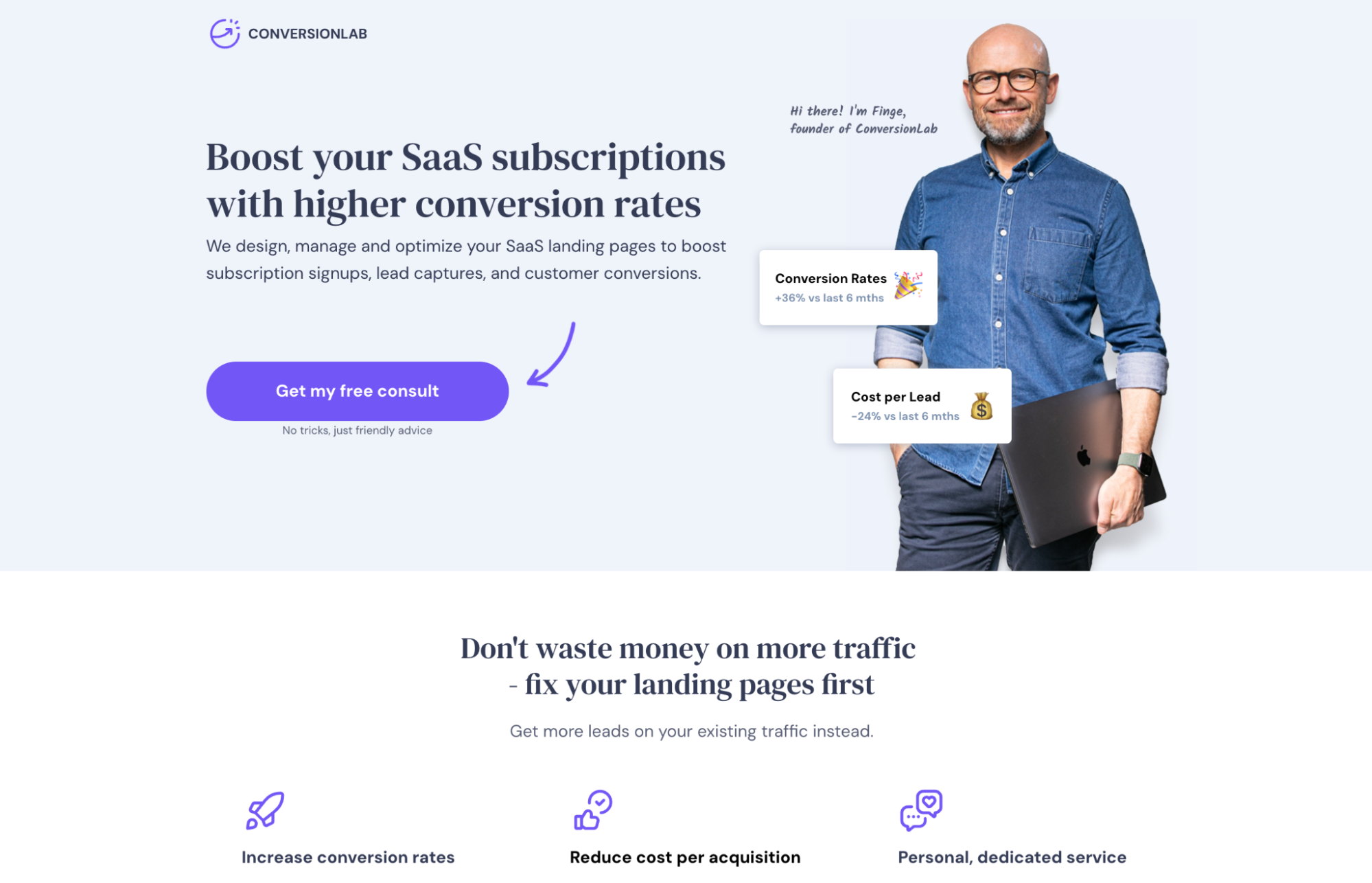
Why it converts
ConversionLab uses an exit popup to catch users who are about to leave the page without doing anything.
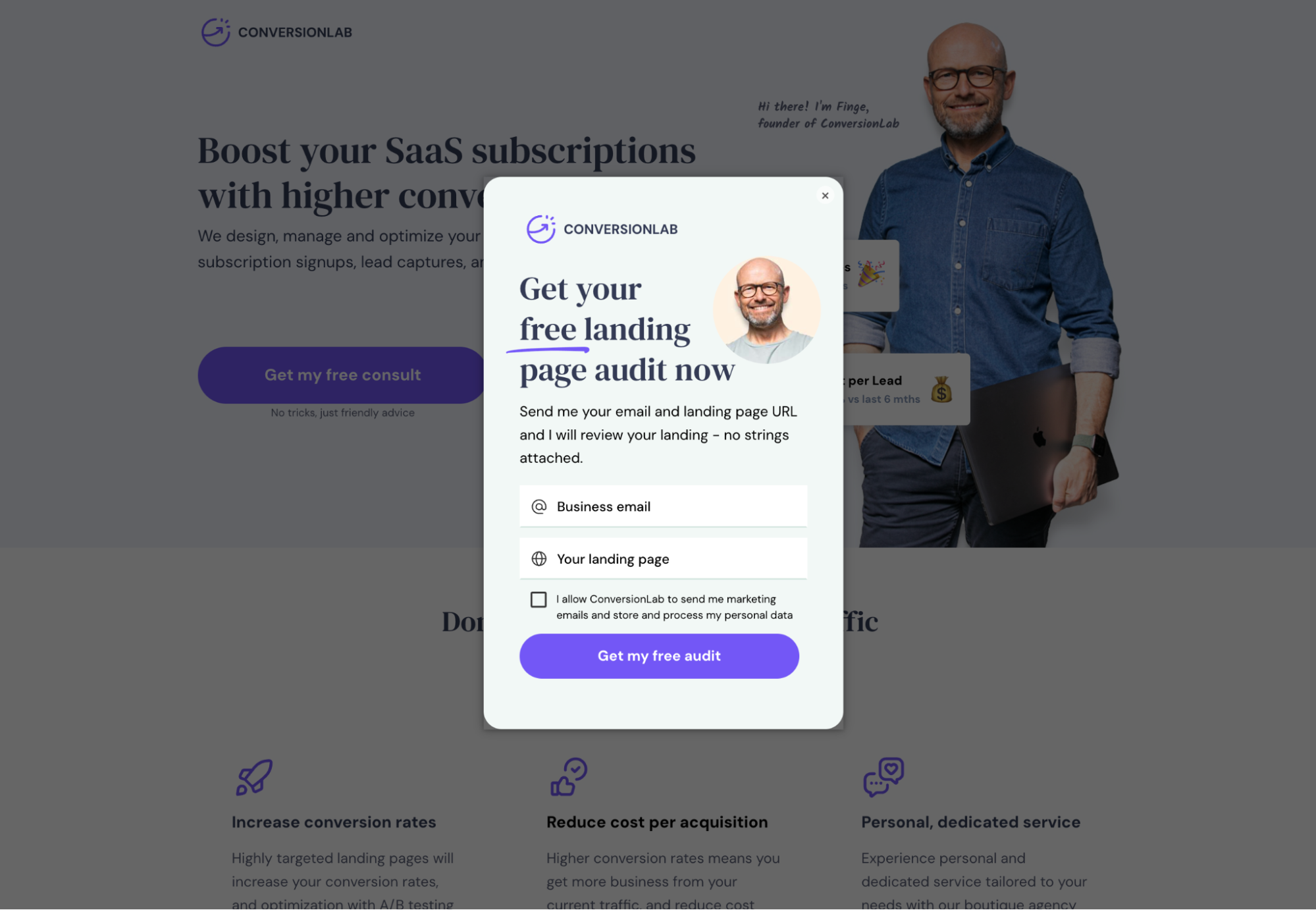
This popup helps keep visitors on the page by giving them a special offer or reminder, like a discount or free consultation. This keeps users interested and gives them a reason to stay, making it more likely they’ll take action. By showing an offer at just the right time, ConversionLab turns a potential loss into a new lead or customer.
Also, the design of the page is simple and clean. Using lots of white space and simple design elements makes it easy for visitors to understand the message quickly without distractions. This makes the page more user-friendly.
The page also shows a picture of the founder, which helps make a personal connection. Seeing a real person behind the company makes it feel more trustworthy.
This personal touch helps visitors feel like they are dealing with a real, experienced professional, which can increase trust and make them more likely to convert.
Tips for building your own
To apply ConversionLab’s approach, consider testing an exit popup. Use it to offer a discount, free resource, or consultation when a user seems like they are about to leave without taking action.
Plus, keep your design simple. Make sure your main message and call to action are clear, without anything extra to distract visitors. And if you can, add a personal touch, like a photo or story about the founder, to help make an emotional connection with your audience.
10. Webistry
Websitry is a growth marketing agency. This particular landing page focuses on how they help businesses follow Quebec’s Law 25, which deals with privacy rules and managing cookies on websites.
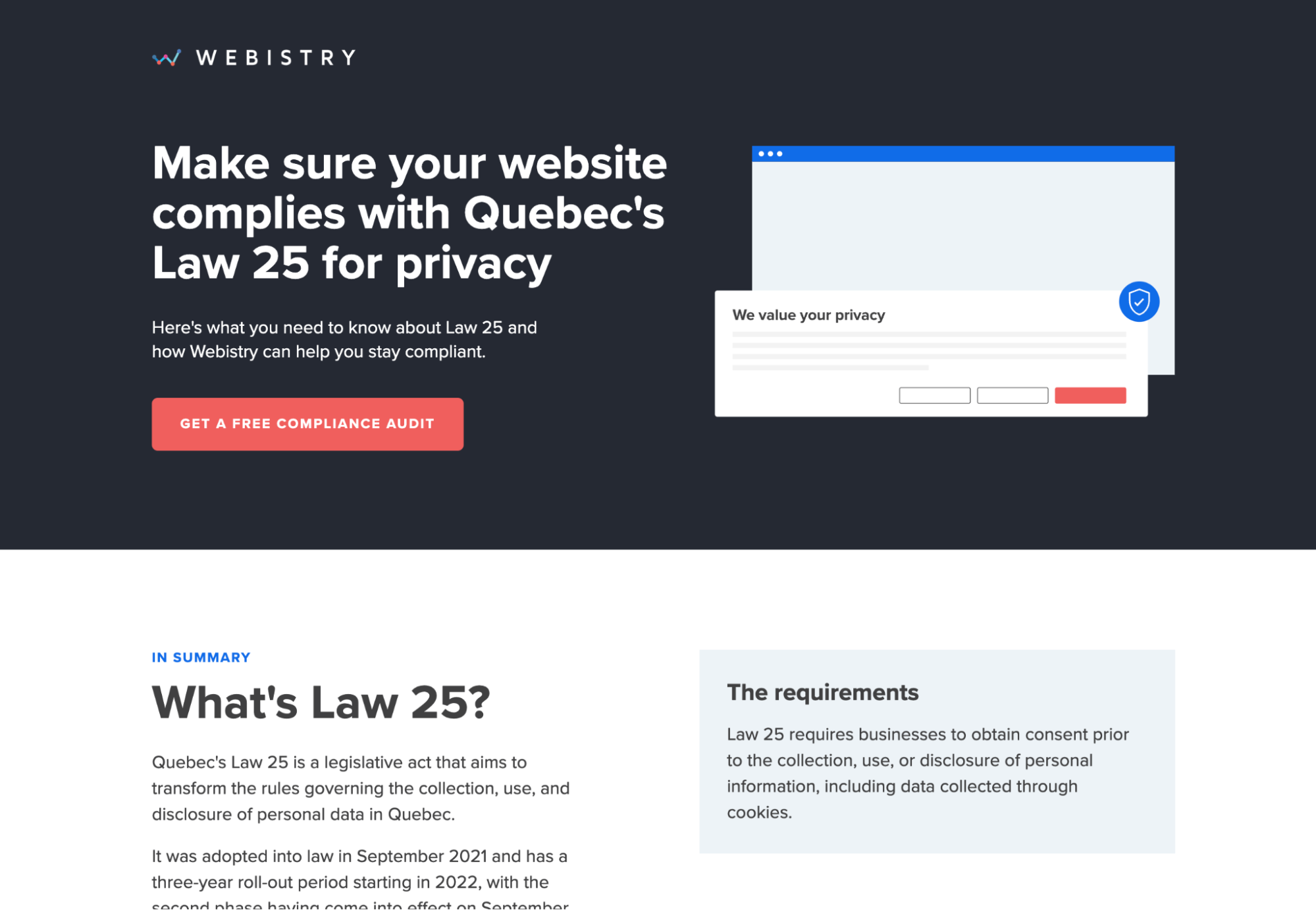
Why it converts
The page does a job of explaining how the problem (Law 25 compliance in this case) affects businesses and what they need to do to stay compliant. Then it offers a free compliance check, making it easy for businesses to see if they are following the rules and what they need to fix.
The page is all about teaching users about the law and showing simple steps to stay compliant. It has one clear call to action—signing up for a free audit—so users know what to do next.
The page also talks about the risks of not following the law, like getting big fines. This helps create urgency and makes people want to take action. It shows the benefits of Websitry’s services step-by-step, making it clear how they can help manage privacy and compliance.
Tips for building your own
When building your own landing pages, focus on educating your visitors on the problems your offer can solve for them. Use clear examples to help them understand the value you are offering and how it can make their lives easier.
Use a simple and direct call to action that makes the next step easy to understand and follow. Make sure it stands out visually so people can’t miss it.Finally, show the risks or downsides of not acting to create urgency. It may not be actual monetary fines like this example, but talk about what the future could look like if your visitor does nothing. Maybe it’s lost market share, missed revenue, stress, etc.
How Unbounce can help agencies build better landing pages
Landing pages are a must-have tool for any marketing agency. They’re key to capturing leads and driving actions that help your clients’ businesses grow (and your own business too).
Start by setting clear goals for each page. Then, keep the design simple and clear. A clean layout with a strong call to action can make a huge difference. Keep your message short and focused.
And what’s more, test and tweak to see what works and continuously optimize. Analyzing performance data will show you what’s working and what isn’t, helping you improve over time.
But if there’s one thing we want to stress, it’s that you need to stay curious, keep learning, and above all:
Get started.
With Unbounce, the “getting started” part is easy. You’ll have access to:
- An AI copywriting tool that can write optimized copy for you
- The tools to launch A/B tests in minutes
And of course, the landing page builder thousands of Unbounce users have used and loved for more than a decade.
SUBSCRIBE
Don’t miss out on the latest industry trends, best practices, and insider tips for your marketing campaigns
How Unbounce can help agencies build better landing pages
Landing pages are a must-have tool for any marketing agency. They’re key to capturing leads and driving actions that help your clients’ businesses grow (and your own business too).
Start by setting clear goals for each page. Then, keep the design simple and clear. A clean layout with a strong call to action can make a huge difference. Keep your message short and focused.
And what’s more, test and tweak to see what works and continuously optimize. Analyzing performance data will show you what’s working and what isn’t, helping you improve over time.
But if there’s one thing we want to stress, it’s that you need to stay curious, keep learning, and above all:
Get started.
With Unbounce, the “getting started” part is easy. You’ll have access to:
- 100+ proven landing page templates
- An AI copywriting tool that can write optimized copy for you
- The tools to launch A/B tests in minutes
And of course, the landing page builder thousands of Unbounce users have used and loved for more than a decade.
![[Build – MOFU] Landing Page Templates – V1 – 2024 landing page templates](https://unbounce.com/photos/blog-visual-cta-2x-v2.jpg)
